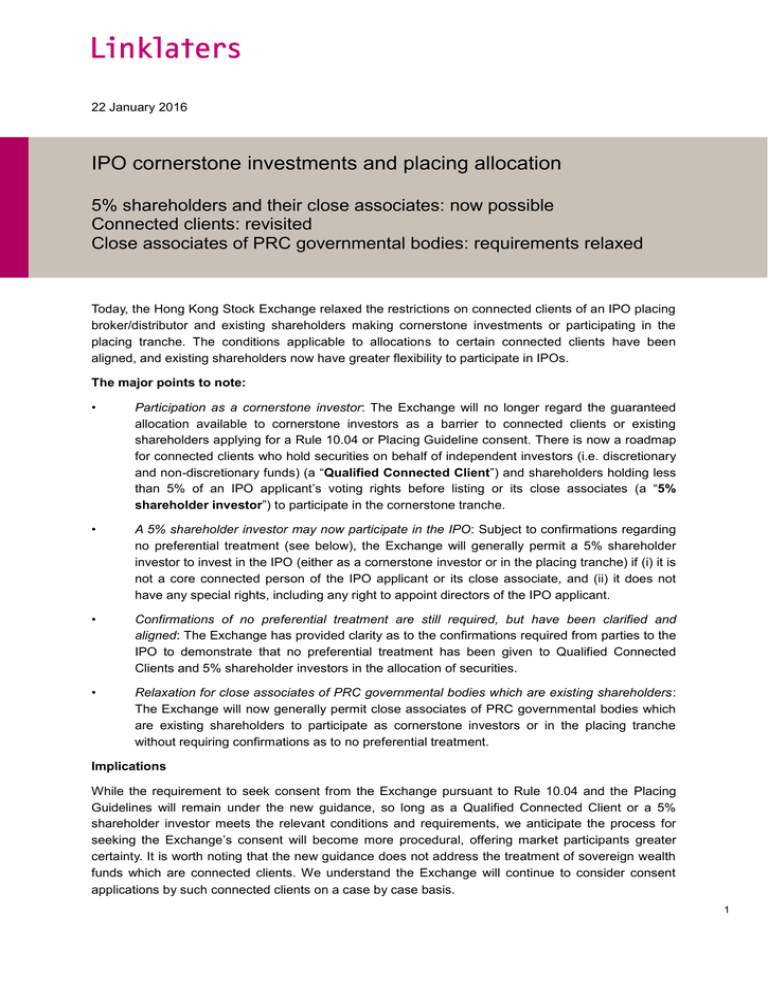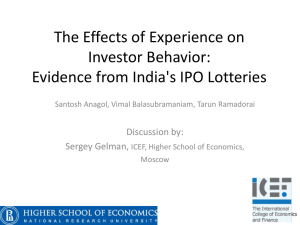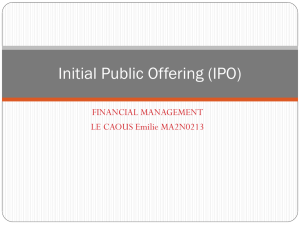
22 January 2016
IPO cornerstone investments and placing allocation
5% shareholders and their close associates: now possible
Connected clients: revisited
Close associates of PRC governmental bodies: requirements relaxed
Today, the Hong Kong Stock Exchange relaxed the restrictions on connected clients of an IPO placing
broker/distributor and existing shareholders making cornerstone investments or participating in the
placing tranche. The conditions applicable to allocations to certain connected clients have been
aligned, and existing shareholders now have greater flexibility to participate in IPOs.
The major points to note:
•
Participation as a cornerstone investor: The Exchange will no longer regard the guaranteed
allocation available to cornerstone investors as a barrier to connected clients or existing
shareholders applying for a Rule 10.04 or Placing Guideline consent. There is now a roadmap
for connected clients who hold securities on behalf of independent investors (i.e. discretionary
and non-discretionary funds) (a “Qualified Connected Client”) and shareholders holding less
than 5% of an IPO applicant’s voting rights before listing or its close associates (a “5%
shareholder investor”) to participate in the cornerstone tranche.
•
A 5% shareholder investor may now participate in the IPO: Subject to confirmations regarding
no preferential treatment (see below), the Exchange will generally permit a 5% shareholder
investor to invest in the IPO (either as a cornerstone investor or in the placing tranche) if (i) it is
not a core connected person of the IPO applicant or its close associate, and (ii) it does not
have any special rights, including any right to appoint directors of the IPO applicant.
•
Confirmations of no preferential treatment are still required, but have been clarified and
aligned: The Exchange has provided clarity as to the confirmations required from parties to the
IPO to demonstrate that no preferential treatment has been given to Qualified Connected
Clients and 5% shareholder investors in the allocation of securities.
•
Relaxation for close associates of PRC governmental bodies which are existing shareholders:
The Exchange will now generally permit close associates of PRC governmental bodies which
are existing shareholders to participate as cornerstone investors or in the placing tranche
without requiring confirmations as to no preferential treatment.
Implications
While the requirement to seek consent from the Exchange pursuant to Rule 10.04 and the Placing
Guidelines will remain under the new guidance, so long as a Qualified Connected Client or a 5%
shareholder investor meets the relevant conditions and requirements, we anticipate the process for
seeking the Exchange’s consent will become more procedural, offering market participants greater
certainty. It is worth noting that the new guidance does not address the treatment of sovereign wealth
funds which are connected clients. We understand the Exchange will continue to consider consent
applications by such connected clients on a case by case basis.
1
Background
The Placing Guidelines (Appendix 6 to the Hong Kong Listing Rules) require consent from the
Exchange to allow distributors to allocate IPO shares in the placing tranche (including participation as
cornerstone investors) to connected clients, directors and existing shareholders. In addition, Rules
10.03 and 10.04 restrict an IPO applicant from offering shares to its directors and existing
shareholders in a preferential manner. The restrictions are put in place to address regulatory concerns
that connected clients or existing shareholders and their associates may exert substantial influence
over distributors and/or IPO applicants to obtain preferential treatment in allocations.
The Exchange acknowledges that not all connected clients and existing shareholders can exert
substantial influence over IPO allocation decisions, and has in the past issued guidance to explain the
conditions that a Qualified Connected Client or existing shareholder must satisfy in order for
allocations to them to be permitted. The Exchange’s guiding principle is that its consent may only be
granted if it is satisfied that no actual or perceived preferential treatment in the allocation process will
be given to an investor.
The Exchange has reviewed its current practice, the policy rationale of the restrictions, and published
a new guidance letter (GL85-16), aligning, and in some cases relaxing, its current practice (repealing
GL75-14 and LD90-1). The Exchange has not removed the requirement to seek its consent pursuant
to Rule 10.04 and the Placing Guidelines, but the consent seeking process is expected to become
procedural.
Participation as a cornerstone investor
In the past, connected clients and existing shareholders had no way of getting the Exchange’s consent
to participate in cornerstone investments due to the assumption of preferential treatment arising from
the guaranteed allocation in the cornerstone participation.
In the new guidance letter, the Exchange explained that it will no longer regard the guaranteed
allocation available to cornerstone investors as a barrier to connected clients or existing shareholders
applying for a Rule 10.04 or Placing Guideline consent. The only requirement of the Exchange is that
such investment be made on the same terms and conditions as other independent cornerstone
investors – i.e., by complying with the conditions set out in GL51-13.
5% shareholder investor: now possible
In the past, the Exchange granted consent to existing shareholders participating in the placing tranche
of an IPO only in very limited circumstances (see LD90-1, which has been superseded by the new
guidance). In the new guidance, the Exchange made clear that an existing shareholder holding less
than 5% of the voting rights of the IPO applicant prior to listing, and its close associates, can
demonstrate that it will not receive any preferential treatment, and thus may participate either as a
cornerstone investor or in the placing tranche with its consent, if the following conditions are satisfied:
(i)
the 5% shareholder is not a core connected person of the IPO applicant or its close associate;
(ii)
the 5% shareholder does not have any special rights, including the power to appoint directors
of the IPO applicant;
(iii)
the public float requirement can be met;
(iv)
the sponsor confirms that, to the best of its knowledge and belief, the 5% shareholder investor
has not received preferential treatment in the IPO allocation (other than, in the case of a
2
cornerstone investment, the preferential treatment of a guaranteed allocation at the IPO price)
(the “Sponsor Confirmation”);
(v)
the IPO applicant confirms that no preferential treatment in the IPO application has been given
to the 5% shareholder investor and (in the case of a cornerstone investment) the material
terms of the cornerstone investment agreement of the 5% shareholder investor are not more
favourable compared with other cornerstone investors (the “IPO Applicant Confirmation”);
and
(vi)
in the case of a participation in the placing tranche, the bookrunners confirm that no
preferential treatment in the IPO application has been given to the 5% shareholder investor
(the “Bookrunners Confirmations”).
These conditions are also applicable to holders of convertible instruments issued by the IPO applicant.
The new guidance contains prescribed wording for confirmations to be given by various parties, some
of which allow qualifications to be included and the relevant party giving the confirmations to rely on
confirmations given by others.
The Exchange believes there is a greater risk of actual or perceived preferential treatment in favour of
shareholders with a larger percentage shareholding, as they will have greater influence over the
decision of the IPO applicant, in particular if the shareholder is otherwise connected or has the right to
appoint directors. The general benchmark is set at a 5% interest in voting rights prior to listing, which
aligns with the minimum shareholding for triggering substantial shareholder disclosures under Part XV
of the Securities and Futures Ordinance. Nevertheless, we believe the door is not completely shut for
shareholders holding more than 5% voting rights if the IPO applicant already has an overseas listing
and if unique circumstances apply to it which clearly demonstrate a lack of influence of the
shareholder on the IPO applicant.
Connected client requirements: revisited
In the past, the Exchange accepted that Qualified Connected Clients may be able to demonstrate that
they do not receive any preferential treatment in the allocation process if certain confirmations are
given and conditions are satisfied. These confirmations and conditions depended on whether the
Qualified Connected Clients held securities on a non-discretionary or discretionary basis.
In the new guidance letter, the Exchange has maintained its requirement for confirmations, but the
scope has been aligned and consolidated between both groups of Qualified Connected Clients. In
particular, confirmations that no preferential treatment has been given will be required from each of the
sponsor, the IPO applicant, the bookrunners, the connected distributor and the Qualified Connected
Client itself. The only distinction between the two groups is that the Exchange highlights its heightened
concerns over the risk of preferential treatment being given to discretionary Qualified Connected
Clients by requiring that their connected distributors be excluded from the allocation process in so far
as it relates to their discretionary Qualified Connected Clients. This is less draconian than previous
experiences of the Exchange prohibiting connected distributors from introducing their connected
clients as potential investors, but is nevertheless onerous from a practical perspective.
See the table at the end of this bulletin for a summary of the confirmations required.
Close associates of PRC governmental bodies: requirements relaxed
The Exchange has indicated a different approach for close associates of existing shareholders which
are PRC governmental bodies. In particular, the Exchange will grant consent to such close associates
to participate as cornerstone investors or in the placing tranche without requiring confirmations as to
3
preferential treatment, provided that they: (a) are genuine investors who operate independently of the
PRC governmental bodies; and (b) have no access to material non-public information regarding an
IPO and no influence over the allocation process of the IPO.
We believe this new approach should ease the burden of close associates of Central Huijin to the
extent they participate as cornerstone investors or in the placing tranche of IPOs.
A summary of the conditions
Parties to provide
the relevant confirmations with
Conditions
1. Securities are held on behalf of independent
third parties
Non-discretionary
Basis Conditions
Discretionary Basis
Conditions
Existing Shareholders
Conditions
2. Confirmation that cornerstone investment agreement does not contain any material terms which are more favourable to the
connected client/existing shareholder or its close associates from:
- applicant
- connected broker/distributor
- bookrunners
- connected client
- sponsor
- applicant
3. No preferential treatment confirmations from:
4. Confirmation that connected broker/distributor did not participate in decision-making /discussions regarding allocations to
the connected client from:
- applicant
- connected broker/distributor
- bookrunners
5. Existing shareholder
- is interested in less than 5% of an
applicant’s voting rights
- is not a core connected person or its close
associate
- does not have the power to appoint
directors or any other special rights
6. Allocation to the existing shareholder or its
close associates will not affect the applicant’s
ability to satisfy the public float requirement
Authors: Robert Cleaver, Kevin Cheung, Terri Poon and Christopher Yip
This publication is intended merely to highlight issues and not to be comprehensive, nor to provide legal advice. Should you have any questions on issues reported here or
on other areas of law, please contact one of your regular contacts, or contact the editors.
© Linklaters Business Services (H.K.) Limited. All Rights reserved 2016.
Please refer to www.linklaters.com/regulation for important information on our regulatory position.
We currently hold your contact details, which we use to send you newsletters such as this and for other marketing and business communications.
We use your contact details for our own internal purposes only. This information is available to our offices worldwide and to those of our associated firms.
If any of your details are incorrect or have recently changed, or if you no longer wish to receive this newsletter or other marketing communications, please let us know by
emailing us at marketing.database@linklaters.com.
4






